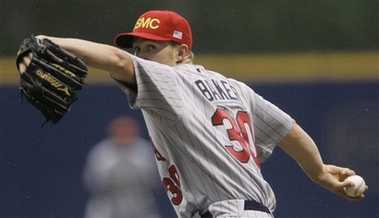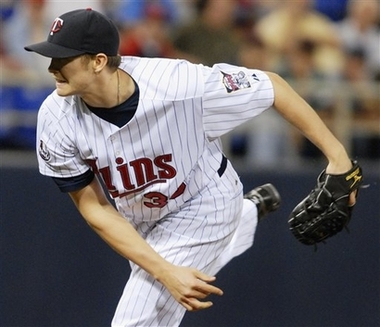September 3, 2007
The Pay Off: Part 1 (Scott Baker)
Despite that, the truism often gets overlooked and forgotten, at least initially, because the payoff doesn't always come immediately. For example, Jack Cust was a first-round pick in 1997 and put up big numbers in the minors for a decade, hitting .286/.429/.518 with 200 homers and 924 walks in 1,114 games. His minor-league track record was beyond strong, yet Cust bounced around constantly as property of the Diamondbacks, Rockies, Orioles, A's, and Padres.
Cust saw a grand total of 169 plate appearances in the majors through the age of 27, with no more than 85 coming in one place. He batted just .222 in those various brief stints as a big leaguer spread over parts of five seasons, and was written off by many as a so-called "Quadruple-A player." That label gets tossed around often when someone with a strong track record in the minors fails to immediately succeed in the majors and it's a label that might have stuck with Cust if not for this season.
After batting .293/.467/.549 with 30 homers and 143 walks in 130 games for the Padres' Triple-A team last season, Cust remained at Portland to begin this year and hit .300/.430/.725 in 25 games. While jaw-dropping, those numbers fit with the rest of Cust's long minor-league track record. No doubt viewing the minor-league veteran as little more than Triple-A depth, the Padres happily traded Cust to the A's in May, receiving either a Player to be Named Later or cash considerations in the exchange.
Given a chance for regular playing time in the majors for the first time since 2003, Cust homered in his A's debut, went deep a total of six times in his first week with the team, and hasn't looked back. Labeled as a Quadruple-A player and looked at as a bust just months ago, Cust has hit .266/.405/.536 with 23 homers and 77 walks in 101 games. No one, not even the A's, expected that type of production from Cust, but his .286/.429/.518 line in 1,114 minor-league games showed that it was possible.
 And why? Because for the most part young players with strong minor-league track records eventually develop into good major-league players. What does all of this have to do with the Twins? A lot, actually. On the most basic level, all of the success that the Twins have experienced over the past seven years has been built upon the development of young players. But for every Joe Mauer or Francisco Liriano who immediately makes a huge impact in the majors, there are multiple players who struggle initially.
And why? Because for the most part young players with strong minor-league track records eventually develop into good major-league players. What does all of this have to do with the Twins? A lot, actually. On the most basic level, all of the success that the Twins have experienced over the past seven years has been built upon the development of young players. But for every Joe Mauer or Francisco Liriano who immediately makes a huge impact in the majors, there are multiple players who struggle initially.
From Justin Morneau and Michael Cuddyer to Torii Hunter and Johan Santana, most of the team's best players struggled before establishing themselves in the majors. Both Hunter and Santana were demoted back to Triple-A despite having multiple big-league seasons under their belts, Morneau batted .239 in the year before he won the AL MVP, and Cuddyer needed over 1,000 plate appearances with the Twins before he began hitting like his minor-league track record suggested he could.
None of which is to say that every young player should be given never-ending patience or an endless leash, because the key is the quality track record. Luis Rivas was young and got handed a starting job season after season, but there was nothing in his minor-league performance to suggest that he was capable of becoming a good major-league player. Sure enough, he batted .262/.307/.383 in six years with the Twins and has spent the past two seasons putting up mediocre numbers at Triple-A.
However, when the young player has a strong minor-league track record patience is warranted when they don't immediately duplicate those numbers in the majors. Of course, that's a lot easier said than done. I tend to give the benefit of the doubt to young players when they come along with a promising track record, perhaps to the point of overvaluing potential and undervaluing experience. Most people seem to be at the opposite end of the spectrum, quickly souring on youth that struggles.
A good example of that is Scott Baker, who moved quickly through the minors after being taken in the second round of the 2003 draft. After beginning his professional career with a 2.44 ERA and 156-to-27 strikeout-to-walk ratio in 166 innings between Single-A and Double-A, Baker posted a 3.57 ERA and 143-to-41 strikeout-to-walk ratio in 189 innings at Triple-A. That earned him a call-up to Minnesota in 2005, where he posted a 3.35 ERA in 53.2 innings with the Twins.
 A 23-year-old former second-round pick with a strong track record and rare success in his first taste of the majors, Baker's future looked bright however you sliced it. Then he began last season in the Twins' rotation and struggled, going 5-8 with a 6.37 ERA in 16 starts. Despite still being just 24 years old and posting a 2.67 ERA in a dozen starts at Triple-A following a demotion, many Twins fans soured on Baker almost immediately.
A 23-year-old former second-round pick with a strong track record and rare success in his first taste of the majors, Baker's future looked bright however you sliced it. Then he began last season in the Twins' rotation and struggled, going 5-8 with a 6.37 ERA in 16 starts. Despite still being just 24 years old and posting a 2.67 ERA in a dozen starts at Triple-A following a demotion, many Twins fans soured on Baker almost immediately.
Suddenly it was tough to find someone who had any faith in his ability to get big-league hitters out. He was an afterthought whenever the team's long-term rotation was discussed and frequently mentioned as someone who the Twins should be trying to trade. Rarely critical of anyone, FSN announcers Dick Bremer and Bert Blyleven seemingly made it their mission to play up Baker's struggles and focus on his weaknesses each time he took the mound.
Baker began this season back at Rochester, where he once again performed very well with a 3.16 ERA and 41-to-4 strikeout-to-walk ratio in 42.2 innings alongside Kevin Slowey and Matt Garza in the Triple-A rotation. Called up in mid-May, Baker was fantastic against the Brewers in his first start, nearly tossing a complete game before settling for 8.1 innings of two-run ball. Following his impressive season debut, I wrote the following about Baker:
Judging from the comments left here and the e-mails I've received on the subject, it's clear that Baker's performance last season convinced a huge percentage of Twins fans that he'll never be a good major-league pitcher. In fact, I'm not sure that I've ever seen a fan base turn so quickly and strongly on a young player based on one bad half season. I've been relatively steadfast in my support of Baker and, while it was just one game, Saturday's start against the Brewers showed why: Baker can pitch.
Unfortunately, Baker struggled during his next four outings, at which point all patience seemed to disappear and the level of criticism intensified even further. In an effort to calm the amazingly negative reaction to his struggles, I compared Baker's first 30 big-league starts to a handful of successful Twins pitchers who also struggled through that early stage of their careers. When the level of criticism being thrown at Baker grew even stronger, I wrote:
The amazingly negative reaction he gets from many Twins fans has sort of forced me into a position of defending him to some degree. ... He now has a 5.14 ERA and 129-to-41 strikeout-to-walk ratio in 184 career innings, which are the type of numbers that bode well for the future of a 25-year-old pitcher with an outstanding minor-league track record. For whatever reason many fans seemingly view him as a worthless bum, but he clearly doesn't deserve that level of vitriol. He deserves some patience.
That was written on July 2. It's just two months later, but you'll be hard-pressed to find anyone willing to call him a bum or a Quadruple-A pitcher now, because all of those fans who made a habit of ripping Baker have seemingly disappeared. Suddenly the talking points put forth by Bremer and Blyleven don't sound like they've been put together by some sort of anti-Baker political campaign, and he's once again viewed as a prominent part of the team's future.
Why the sudden, dramatic change in the public's perception of Baker? Because after a couple dozen rough starts early in his career, a 25-year-old former second-round pick with a strong minor-league track record and initial big-league success has begun consistently pitching well in the majors. In other words, for the most part young players with strong minor-league track records eventually develop into good major-league players.
 Baker took a perfect game into the ninth inning Friday against the Royals and had a no-hitter with two outs remaining before Mike Sweeney's bloop single ruined history. He settled for his first career complete-game shutout, and since comparing Baker's sub par numbers through 30 career starts to other Twins pitchers through the same point in their careers, he's gone 7-4 with 3.16 ERA and 65-to-16 strikeout-to-walk ratio in 94 innings spread over 14 starts.
Baker took a perfect game into the ninth inning Friday against the Royals and had a no-hitter with two outs remaining before Mike Sweeney's bloop single ruined history. He settled for his first career complete-game shutout, and since comparing Baker's sub par numbers through 30 career starts to other Twins pitchers through the same point in their careers, he's gone 7-4 with 3.16 ERA and 65-to-16 strikeout-to-walk ratio in 94 innings spread over 14 starts.
Baker now has a 4.67 ERA and 179-to-55 strikeout-to-walk ratio in 258 career innings, which are the type of numbers that you'd expect him to turn in given his minor-league track record and the type of performance that makes a 25-year-old pitcher a long-term building block. You've now read it enough to know it, so say it with me: For the most part young players with strong minor-league track records eventually develop into good major-league players. And as was always the case, Baker can pitch.
Once you're done here, check out my latest "Daily Dose" column over at Rotoworld.

